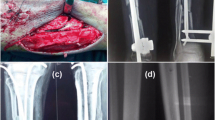Summary
Primary medullary nailing of femoral fractures is burdened by the risk of central and pulmonary complications in patients with polytrauma, especially in conjunction with craniocerebral or thoracic trauma. This also applies to unreamed medullary nailing. Primary treatment with external fixation necessitates secondary surgery with an altered procedure, the timing of which is not predictable. Plate osteosynthesis with anatomical repositioning of the fragments and rigid fixation is a technically demanding procedure, but can lead to fragment necrosis due to fragment denudation. In a prospective study conducted from 1 September 1994 to 30 June 1996 on 17 polytraumatized patients (average ISS: 30 points), simple femoral stem fractures (A-1 to B-3 of the AO-classification) were stabilized by elastic plate osteosynthesis using biological technique. While cautiously preserving the periosteal and muscle connections to the bone, a plate is inserted as a bridge without any interfragmentary compression. At least two to four holes are left free in the center of the plate. This allows micro-movements in the fracture gap without the risk of material fatigue. All of the fractures were immediately stabilized on the day of the accident.
In four patients with severe craniocerebral trauma or manifest shock, the procedure was changed to plate osteosynthesis after application of primary external fixation. Secondary injuries (joint and pelvic fractures or craniocerebral trauma) delayed early loading in 12 cases. Four patients were mobilized postoperatively under partial loading. A fixation callus was radiologically detectable on average 6 weeks after surgery. This often allowed additional loading, depending on the secondary injuries. Full loading was possible after 14 weeks.
Complications included one case of surgery-related malpositioning, one soft-tissue infection, one case of plate detachment after a fall and one case of periosseous calcification. There were no cases of bone infections or pseudoarthroses. Elastic plate osteosynthesis is thus a conservative osteosynthesis procedure with a low complication rate in polytraumatized patients, even in those with simple femoral fractures.
Zusammenfassung
Bei Patienten mit Polytrauma ist die primäre Marknagelung bei Oberschenkelbrüchen speziell mit Schädel-Hirn-Trauma (SHT) oder Thoraxtrauma wegen zentraler und pulmonaler Komplikationen risikoreich. Dies gilt auch für die ungebohrte Marknagelung. Die Erstversorgung mit dem Fixateur externe macht einen Zweiteingriff mit Verfahrenswechsel notwendig, dessen Zeitpunkt nicht vorhersehbar ist. Die Plattenosteosynthese mit anatomischer Reposition der Fragmente und rigider Fixation ist ein technisch anspruchsvolles Verfahren, das jedoch wegen der Fragmentdenudierung zur Fragmentnekrose führen kann. In einer prospektiven Studie wurden in der Zeit vom 01. 09. 1994 bis zum 30. 06. 1996 bei 17 polytraumatisierten Patienten (durchschnittlicher ISS: 30 Punkte) einfache Oberschenkelschaftfrakturen (A-1 bis B-3 nach AO-Klassifikation) mit einer elastischen Plattenosteosynthese in biologischer Technik stabilisiert. Unter strenger Schonung der Periost- und Muskelverbindungen des Knochens wird die Platte überbrückend und ohne jede interfragmentäre Kompression eingebracht. Zentral bleiben mindestens 2–4 Plattenlöcher unbesetzt. Dies erlaubt Mikrobewegungen im Frakturspalt ohne das Risiko der Materialermüdung. Alle Frakturen wurden sofort am Unfalltag stabilisiert. Bei 4 Patienten mit schwerem SHT oder manifestem Schock erfolgte nach primärer Fixateur-externe-Anlage die Plattenosteosynthese als Verfahrenswechsel. Begleitverletzungen (Gelenk-, Beckenfrakturen oder SHT) verzögerten in 12 Fällen die frühzeitige Belastung; 4 Patienten konnten unter Teilbelastung postoperativ mobilisiert werden. Im Mittel war 6 Wochen nach der Operation ein Fixationskallus radiologisch nachweisbar, der eine zunehmende Belastung in Abhängigkeit von den Begleitverletzungen zuließ. Eine Vollbelastung war nach 12 Wochen postoperativ möglich. Komplikationen waren jeweils eine operativ bedingte Fehlstellung, ein Weichteilinfekt, ein Plattenausriß nach Sturz und einmal periossäre Verkalkungen. Knocheninfekte und Pseudarthrosen traten in keinem Fall auf. Die elastische Plattenosteosynthese ist beim polytraumatisierten Verletzten auch bei einfachen Oberschenkelfrakturen ein schonendes, komplikationsarmes Osteosyntheseverfahren.
Similar content being viewed by others
Author information
Authors and Affiliations
Rights and permissions
About this article
Cite this article
Schmidtmann, U., Knopp, W., Wolff, C. et al. Results of internal elastic plate osteosynthesis of simple femoral shaft fractures in polytraumatized patients. An alternative procedure. Unfallchirurg 100, 949–956 (1997). https://doi.org/10.1007/s001130050217
Issue Date:
DOI: https://doi.org/10.1007/s001130050217




